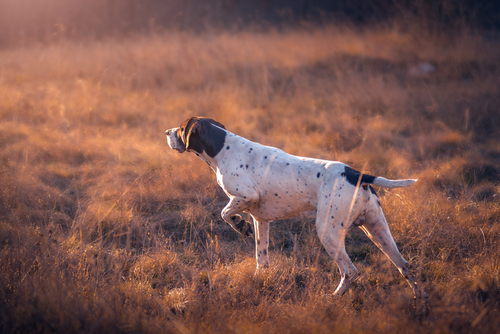Every dog has the natural urge to chase to a certain degree. The descendants of wolves, dogs enjoy the predatory pastimes of stalking, sneaking, pouncing, and shaking. For specialized hunting breeds like Airedales, German Pointers, and Beagles, however, this prey drive can be expected to be dialed up quite high. Rather than training hounds with the goal to entirely redirect their wolf-like hunting instinct, the people who have historically bred hunting dogs have instead valued dogs who combined these powerful instincts with impressive self-control and obedience.
If you are the proud owner of a hunting dog, you’re no doubt keenly aware of your dog’s powerful chase instincts! No squirrel, gopher, rabbit, cat, bird, or leaf floating on the breeze will rest easy when your watchful pup is near. The catch, of course, is that this hunting drive isn’t so fun when you’re at the dog park, out for walks around the block, or when your mail carrier is near.
If not controlled through proper training, your furry companion’s desire to take off running after exciting objects (read: literally anything that moves) puts your dog’s safety at risk, endangers wildlife and domestic animals, and puts your safety at risk every time you’re nearly yanked off your feet.
It’s important to keep in mind, though, that your dog’s prey drive is a healthy, natural instinct that displays his excellent breeding. If you approach his behaviors as negative or deliberate acts of rebellion, your dog won’t realize his potential to be a proud ambassador of his breed.
Rather, by properly harnessing and redirecting your dog’s hunting instincts, you’ll
- improve his self-esteem,
- expand his enjoyment of life,
- and open doors for your dog to experience fun environments that would otherwise be too dangerous to explore.
Here are a few practical tips for training a dog with a high prey drive.
1. Reduce or eliminate his exposure to trigger objects and animals.
This means avoiding dog parks, walking near small animals, and opportunities for your dog to be unsupervised outdoors—even in his own backyard. The sheer thrill your dog will experience by satisfying his predatory chase drive in any of these situations will create a powerful positive association.
Training your dog NOT to satisfy this urge once he’s learned how incredible it feels to give chase on his own is a lot more work. Don’t be discouraged if your dog has already made this association over and over; it’s still possible to retrain a hunting dog, but you shouldn’t delay proper training any longer.
2. Train your dog in a controlled environment.
Whether you choose your living room, an empty lawn, or a professional setting like All Dogs Unleashed, it’s vital that your training environment be controlled and calm. It will be impossible to begin to train your dog unless you’re guaranteed to be able to catch and hold his attention over and over.
3. Focus on redirection and preventive training.
Since it would be impossible (and of course undesirable) to train your hunting dog not to experience the urge to chase, your training should focus on redirection and preventive training.
You will not be able to get your dog to break off a chase midway, so your job will be to learn your dog’s triggers and catch it immediately when he’s even slightly engaged. A prick of the ears, a lift of the head, a shift in the haunches; there will be cues mere moments before he succumbs to his impulses.
Use commands paired with high-value treats to capture and keep your dog’s attention. Your dog should be left thinking that it will always be far more rewarding to look at you and listen to your commands than to take off after moving objects.
Remember, dogs need us to teach them how to work through challenging situations. Your goal is training your dog to stop immediately and look at you for direction every time he feels that healthy hunting urge.
Commands you will teach, reinforce, and refine include:
- Watch Me
- Leave It
- Come (or other recall command)
- Sit
- Down
- Wait
- Stay
4. Keep your dog leashed until he displays perfect recall.
Until your hunting dog is impeccably trained, he’s got to stay leashed and clipped to you. You cannot risk losing control of him and allowing him to experience that urge of unbridled chase.
5. Create positive opportunities for your dog to satisfy his prey drive.
Once you have completed your dog’s basic obedience training—usually around one year of age—he’s ready to begin taking fun and exciting classes that will create opportunities for him to satisfy his primal, wolf-like urges in healthy ways!
These experiences will increase your dog’s enjoyment of life, reinforce the connection between you as dog and handler, and prevent negative—and even dangerous—behaviors that could otherwise occur as the result of boredom and frustration.



